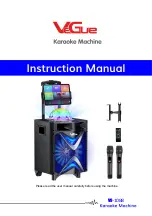
EasyWeld / HandyWeld 160
0-5617 6-9
STICK (MMAW) Welding
Art # A-07704
Figure 6-19: Overhead fillet weld
6.17 Distortion
Distortion in some degree is present in all forms of
welding. In many cases it is so small that it is barely
perceptible, but in other cases allowance has to be
made before welding commences for the distortion
that will subsequently occur. The study of distortion is
so complex that only a brief outline can be attempted
here.
6.18 The Cause of Distortion
Distortion is cause by:
A. Contraction of Weld Metal:
Molten steel shrinks approximately 11 per cent in
volume on cooling to room temperature. This means
that a cube of molten metal would contract approxi-
mately 2.2 per cent in each of its three dimensions.
In a welded joint, the metal becomes attached to the
side of the joint and cannot contract freely. Therefore,
cooling causes the weld metal to flow plastically, that
is, the weld itself has to stretch if it is to overcome the
effect of shrinking volume and still be attached to the
edge of the joint. If the restraint is very great, as, for
example, in a heavy section of plate, the weld metal
may crack. Even in cases where the weld metal does
not crack, there will still remain stresses “locked-
up” in the structure. If the joint material is relatively
weak, for example, a butt joint in 2.0mm sheet, the
contracting weld metal may cause the sheet to become
distorted.
B. Expansion and Contraction of Parent Metal in the
Fusion Zone:
While welding is proceeding, a relatively small vol-
ume of the adjacent plate material is heated to a
very high temperature and attempts to expand in all
directions. It is able to do this freely at right angles
to the surface of the plate (i.e., “through the weld”),
but when it attempts to expand “across the weld” or
“along the weld”, it meets considerable resistance,
and to fulfil the desire for continued expansion, it has
to deform plastically, that is, the metal adjacent to the
weld is at a high temperature and hence rather soft,
and, by expanding, pushes against the cooler, harder
metal further away, and tends to bulge (or is “upset”).
When the weld area begins to cool, the “upset” metal
attempts to contract as much as it expanded, but,
because it has been “upset”, it does not resume its
former shape, and the contraction of the new shape
exerts a strong pull on adjacent metal. Several things
can then happen.
The metal in the weld area is stretched (plastic defor-
mation), the job may be pulled out of shape by the
powerful contraction stresses (distortion), or the weld
may crack, in any case, there will remain “locked-up”
stresses in the job. Figures 6-20 and 6-21 illustrate
how distortion is created.
Art # A-07705_AB
Hot
Hot
Weld
Upsetting
Expansion with
compression
Cool
Figure 6-20: Parent metal expansion
Art # A-07706_AC
Weld
Permanent Upset
Contraction
with tension
Figure 6-21: Parent metal contraction
6.19 Overcoming Distortion Effects
There are several methods of minimising distortion
effects.
A. Peening
This is done by hammering the weld while it is still
hot. The weld metal is flattened slightly and because of
this the tensile stresses are reduced a little. The effect
of peening is relatively shallow, and is not advisable
on the last layer.
Summary of Contents for Cigweld EasyWeld 160
Page 8: ...This Page Intentionally Blank ...
Page 14: ...EasyWeld HandyWeld 160 GENERAL INFORMATION 1 6 0 5617 This Page Intentionally Blank ...
Page 26: ...EasyWeld HandyWeld 160 INSTALLATION 3 4 0 5617 This Page Intentionally Blank ...
Page 32: ...EasyWeld HandyWeld 160 OPERATION 4 6 0 5617 This Page Intentionally Blank ...
Page 56: ...MIG GMAW WELDING 5 24 Manual 0 5617 EasyWeld HandyWeld 160 This Page Intentionally Blank ...
Page 70: ...EasyWeld HandyWeld 160 STICK MMAW Welding 6 14 0 5617 This Page Intentionally Blank ...
Page 78: ...KEY SPARE PARTS 8 4 0 5617 EasyWeld HandyWeld 160 This Page Intentionally Blank ...
Page 80: ...EasyWeld HandyWeld 160 APPENDIX A 2 0 5617 This Page Intentionally Blank ...
Page 83: ...EasyWeld HandyWeld 160 This Page Intentionally Blank ...
















































